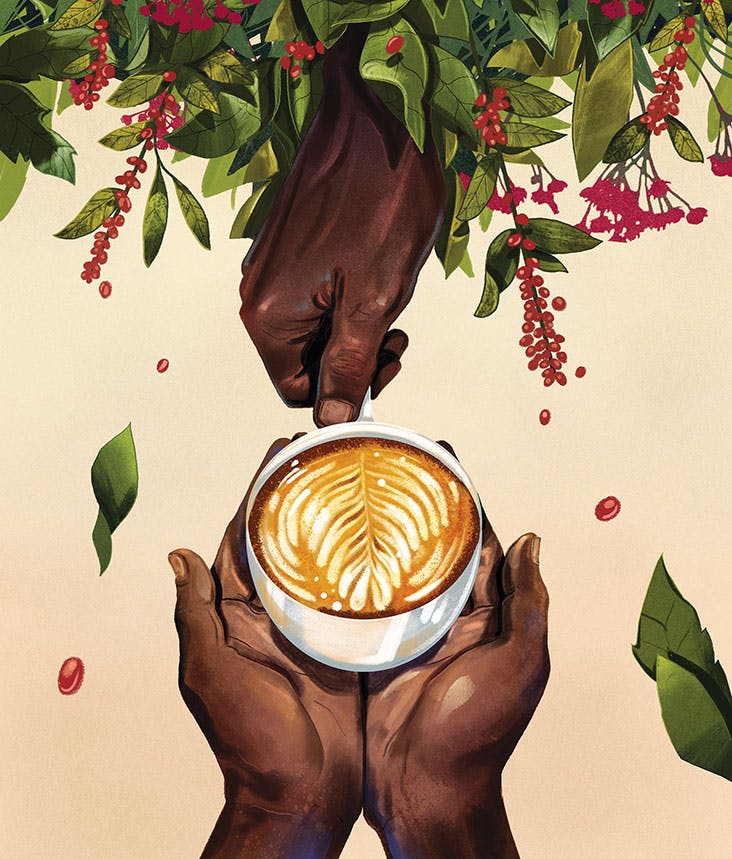Coffe description and facts
7/8/2022, 3:56:40 PM
Coffee is a fruit (Cherry) that contains most of the times 2 coffee beans, some cherries contains only 1 bean. Let's show you how a coffee cherry / bean looks like and it's different stages:
Coffee Story
The most common story explains that back in the 9th century, a monk was roaming the country side in Ethiopia with his goats and one of his goats started eating the red beans from a tree (coffee tree) and got very energetic. The monk took some of the beans to the monastery to ask about this cherry and it's effect. Not understanding or having any idea about this weird effect, the priest threw the beans in the fire, and few minutes later they smelled the roasted coffee flavors! After this incident they started tasting and testing the coffee and since then it evolved over the years to become one of the biggest commodities in the world.
Coffee facts
- A coffee tree produces an average of one and a half to two pounds of coffee per year. That represents from 3 to 4 thousand hand picked coffee cherries and 6 to 8 thousand coffee beans
- One shot of espresso uses approximately 45 coffee beans.
- Coffee is second only to oil as a commodity and second only to water as a beverage.
- Coffee trees take three to four years to mature and bear fruit but they will produce for 20 to 30 years.
- 80% of the world's coffee is produced on family farms of 12 acres... or less!
- Caffeine Contents:
8 oz. Cup = 85 to 110 milligrams.
Espresso-single shot= 35 to 45 milligrams.
- Cappuccino derived its name due to its similarity in color to the robes of an order of Monks called the Capuchins.
Coffee varieties
There are multiple coffee varieties but the most common 2 are Arabicas and Robustas.
Arabicas, are high-grown (usually 3000 feet and up) with a much wider range of taste and, depending on the handling, are considered to be much better in quality.
Robustas, are hearty plants that are grown at lower elevations. They have a much higher caffeine content
The world's best coffee is found among the Arabica or high-grown green coffee beans.
The rule of thumb is-the higher the coffee is grown, the harder the bean, the harder the bean, the better the flavor. The slow maturation of high-grown coffee gives the trees more time to pull all of that rich yumminess out of the soil and often it’s shade grown and organically cultivated.
When coffee is grown in the shade of native trees, several things happen:
* The tropical trees shade the delicate coffee plants from the hot afternoon sun.
* They also provide refuge for many delightful birds that happily eat the critters (bugs) that damage coffee plants.
And the best mountain grown coffee is picked by hand, only upon ripening, one beautiful coffee cherry at a time!
Coffee Harvesting
Many techniques are used to harvest the coffee cherries, of wich:
Machine Harvesting wich is fast and has a low cost but usually the result is bad quality coffee, as it will gather all ripe and unripe coffee fruit.
Strip picking , by striping of the branch, which also results in imprecise quality.
Hand Picking,which is time consumig and requires a lot of labor but will produce better quality as workers can choose the ripe fruits
Coffee Processing
The Dry or Natural Method is the oldest and simplest method for “curing” green coffee beans. It’s much less expensive because it doesn’t require all the fancy equipment. It takes a few weeks to complete and minor differences in the process vary widely.
The coffee cherries are left to dry in the sun, then raked free of the dried fruit and then bagged along with whatever remnants may be.
This is a bit oversimplified but the point is this process results in something wonderful in the cup called “body”. The dry processed coffee demonstrates rich, earthy body.
Honey processing: it is more common, the skin is removed and 100% of mucilage is left on seed
Washed process:
It has been washed free of the normal dust particles of left over fruit, that you would see in a bag of coffee employing the dry method. It’s also “clean” in the cup. The acids shine through with bright and lively vitality like a sunny spring morning after the rains!
But the draw back is that there is a loss of body
Washed coffee (the wet method) is more elaborate and expensive than the dry process. It can only be used in areas where water supply is pure and plentiful.
The wet process varies widely but goes something like this:
* Fresh picked ripe green coffee beans, or cherries are immediately plunged into a large tank of water where the over-ripe or shriveled cherries float to the top and are removed.
* The good fruit that’s left gets sent to a de-pulping machine that strips the fruit from the seed or bean.
* The green coffee beans are then sorted by a series of rotating cylindrical grates called sieves. This process holds back the skins and gradually sorts the beans out by size.
* The beans end up sorted by size into separate stone tanks where the seeds ferment for approximately 48 hours to loosen the remaining pulp.
* The fermented mucilage is then washed by running the coffee down a series of elevated waterways where the beans are even further sorted by size. The coffee ends up in stone drainage tanks where it’s held until the water drains away.
The wet method is highly desired by many as the more sophisticated treatment for fine coffees. Washed coffees are very “clean in the cup”, with bright and vibrant acidity.
Washed coffee can demonstrate more vibrant acidity and a "cleaner taste" in the cup.

